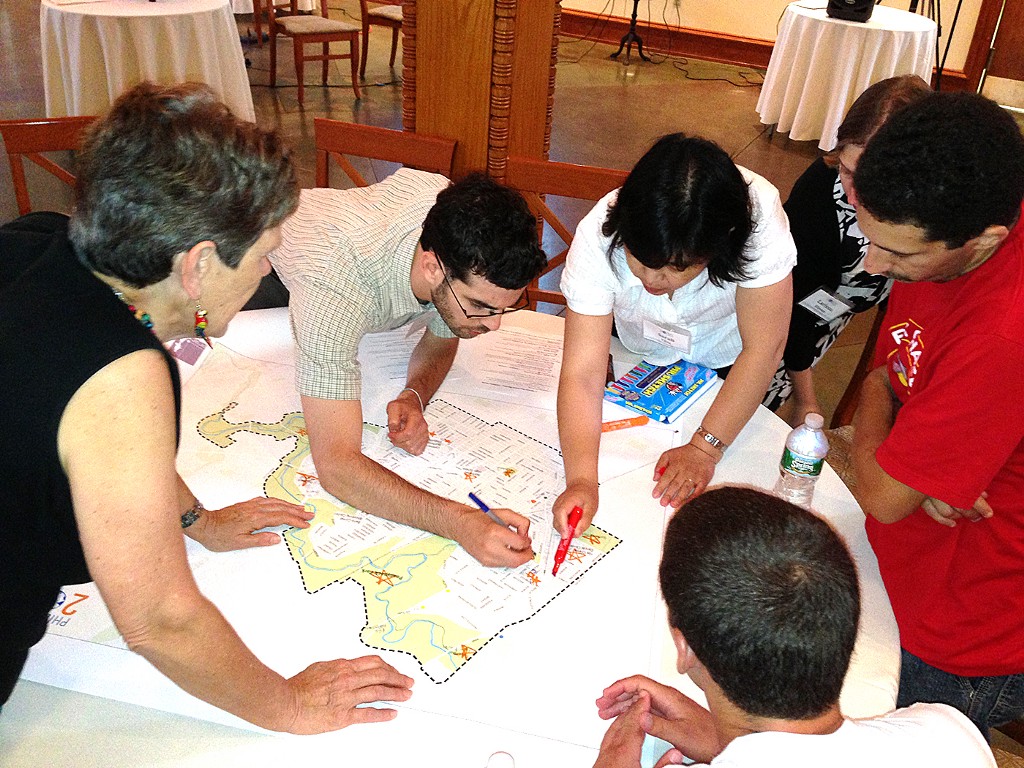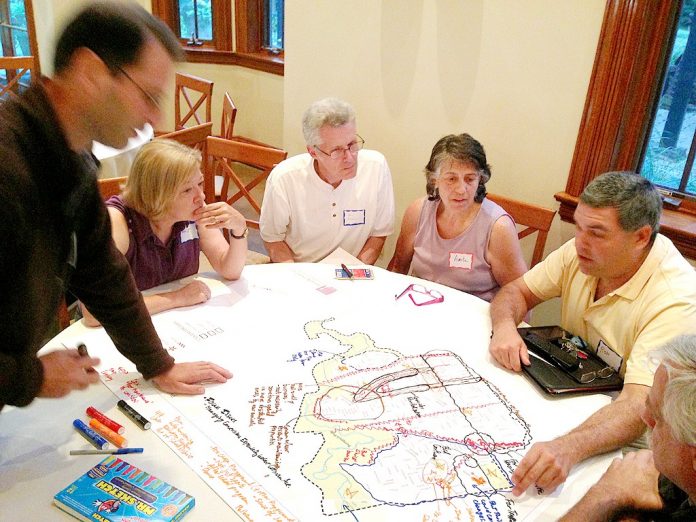About 75 people had their say last Thursday when officials from the City Planning Commission hosted the first public meeting for the Philadelphia2035 “Central Northeast District Plan” at Knowlton Mansion. WILLIAM KENNY / TIMES PHOTOS
One group of Northeast Philly residents recommended new pedestrian bridges spanning the 12-lane Roosevelt Boulevard. Another group proposed stricter laws against duplexes and rental homes. A third group said that the community needs better public transportation and more bicycle lanes.
In all, about 75 people had their say last Thursday when officials from the City Planning Commission hosted the first public meeting for the Philadelphia2035 “Central Northeast District Plan” at Knowlton Mansion.
Philadelphia2035 is an effort by the Planning Commission to create blueprints for future physical development of the city using direct input from the people who will be most affected by development — the people who live, work and do business in the city. The Central Northeast is one of 18 districts across the city where planners have been or will be meeting with community stakeholders over the next several years to formulate localized plans.
The Central Northeast District is mostly west of the Boulevard and includes a diverse mix of neighborhoods from Lawndale and Castor Gardens to the south, Fox Chase and Burholme to the west, Rhawnhurst and Bell’s Corner to the north and Lexington Park to the east.
“It’s everybody’s responsibility to take part in the long-term plan,” said Project Manager Michael Thompson, who described the Planning Commission as “the stewards of the long-term vision of the City of Philadelphia.”
The plan is intended to guide capital investment in the public infrastructure, while defining desired zoning designations for privately held land.
At last week’s event, Planning Commission staff split the crowd of meeting-goers into small groups and asked them to identify community assets and problems on maps of the district. Thompson and David Ortiz, the project co-manager, summarized some telling demographic data for the district.
The population of 78,266, as of the 2010 U.S. Census, represented an 8-percent increase from 1980. Some sections of the district grew in population by 15 percent from 2000 to 2010. Meanwhile, the median age was 38.7 years in 2010 and had declined about five years from 1980.
District-wide, 22 percent of the population is foreign-born, which is almost double the citywide rate. The district was 67 percent white and 11 percent Latino, Asian or African-American in the 2010 census. The district is considered less diverse ethnically than the city as a whole, based on a “diversity index” used by the city, although southern areas of the district had ethnic diversity on par or greater than the city as a whole.
In the district, the homeownership rate (61 percent) and vehicle ownership rate (84 percent of households) are above citywide averages, while the poverty rate is about half the citywide rate of 25 percent. Just 12 percent of homes in the district were built prior to 1939, compared to 40 percent for the entire city.
Employment-wise, 21 percent of residents travel to Center City for work, while 15 percent go to Montgomery County, 8 percent to Bucks County and 8 percent to the Far Northeast. The largest employers in the district are Fox Chase Cancer Center (2,700), Nazareth Hospital (1,200) and Jeanes Hospital (1,000). There are about 17,500 jobs in the district.
The land area covers about 4,000 acres, not including city streets. About half of the land has residential uses, with 78 percent of the residential land occupied by “single-family” dwellings, such as single, twin and row homes. The highest concentration of rental residential properties is south of Cottman Avenue between Castor and Bustleton avenues, Thompson said.
Parkland occupies 31 percent of the district, with Pennypack Park accounting for most of that. Other land uses include “commercial consumer” at 5 percent, industrial at 2 percent and water (such as creeks and streams) at 1.7 percent. According to Thompson, the commercial space has an occupancy rate of 86 percent. While 500,000 square feet of new commercial space has been built since 1995, the vacancy rate has doubled from 7 percent to 14 percent in that period.
Transportation-wise, about 90,000 vehicles use Roosevelt Boulevard per day, while the Route 70 bus on Cottman Avenue is the district’s busiest SEPTA bus. SEPTA’s Fox Chase commuter train also serves the district. It stops at Ryers Station in Burholme and Fox Chase Station at Rhawn Street and Rockwell Avenue.
Residents concluded the meeting by reporting their concerns and recommendations for the district. The Planning Commission will compile the recommendations taken at last week’s meeting and present a draft plan to the community this fall. The next public meeting is expected to occur in September. A date has not been set. According to Ortiz, the entire district-planning process takes about 10 months.
Thompson encouraged community members, particularly those who hold leadership positions in local civic associations, to sign up for the commission’s Citizens Planning Institute and learn more about community planning practices.
Folks at last week’s public meeting already had some strong opinions about what their community should look like.
One of the groups reported that neighborhoods need more resources for elderly parents with disabled adult children. Others said that the government should be more strict about monitoring rental properties and “absentee landlords.” Another group prioritized the preservation of “green space” with stronger zoning restrictions.
A group of Fox Chase residents wanted to see more continuity in the commercial zone along Oxford Avenue with better pedestrian access to the nearby train station and more “traffic calming” road configurations to promote safety. Similarly, a group of Burholme residents identified the Five Points commercial area at Oxford and Cottman avenues as ripe for improvement. It’s two blocks from the Ryers Station and could benefit from better pedestrian access.
One meeting-goer noted that the Fox Chase Cancer Center and Jeanes Hospital shared campus is the largest employment destination in the district, yet the nearest bus stop is four blocks away. Employees, visitors and even patients must walk residential streets, often at night, to access the medical facilities.
Thompson cautioned that the district plan, once formally adopted later this year, will mean nothing without follow-up.
“The plan isn’t the result of this effort,” he said. “It’s a blueprint for things that will happen.” ••
For information about Philadelphia2035, visit phila2035.org. Visit citizensplanninginstitute.org for Citizens Planning Institute information.

Analyzing the information: A City Planning Commission chart shows where residents of the Central Northeast District commute to work. WILLIAM KENNY / TIMES PHOTOS

Building a plan: Greg Waldman of the city Commerce Department (center) and Sarah Chiu (center right) help residents Linde Lauff (left) and Brian Shunsky (right), both of Fox Chase, and Nicholas Boccalupo of Burholme plan their communities.. WILLIAM KENNY / TIMES PHOTOS





